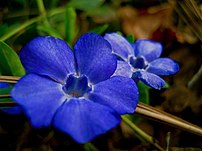[amazon_link asins=’B009ZIGDIG,B004B6OUSW,B004B6N07O,B00RUDLN24,B0165VBCMW,B004IQ20RI,B009RQMEDY,B0099912A0,B009991282′ template=’ProductCarousel’ store=’finmeacur-20′ marketplace=’US’ link_id=’67148480-0f8e-11e7-ba60-d5daf925400b’]
Botanical Name :Vinca minor
Family :Dogbane/Apocynaceae
Synonym(s): lesser periwinkle, myrtle
Kingdom: Plantae
Order: Gentianales
Genus: Vinca
Species: V. minor
Habitat : .It is a plant native to central and southern Europe, from Portugal and France north to the Netherlands and the Baltic States, and east to the Caucasus, and also in southwestern Asia in Turkey. It has been in North America since the 1700s. It has the capability of taking over large tracts of land by spreading out of control. In many states, such as Michigan, the periwinkle plant has overtaken the natural forest ground cover in deciduous woodlands.
Description:
It is a trailing, viny subshrub, spreading along the ground and rooting along the stems to form large clonal colonies and occasionally scrambling up to 40 cm high but never twining or climbing. The leaves are evergreen, opposite, 2-4.5 cm long and 1-2.5 cm broad, glossy dark green with a leathery texture and an entire margin. The flowers are solitary in the leaf axils and are produced mainly from early spring to mid summer but with a few flowers still produced into the autumn; they are violet-purple (pale purple or white in some cultivated selections), 2-3 cm diameter, with a five-lobed corolla. The fruit is a pair of follicles 2.5 cm long, containing numerous seeds.
click to see the pictures….>..(01).....(.1)……..(2)..….(3).…..(4).…..(5)...
The closely related species Vinca major is similar but larger in all parts, and also has relatively broader leaves with a hairy margin.
Cultivation:
The species is commonly grown as a groundcover in temperate gardens for its evergreen foliage, spring and summer flowers, ease of culture, and dense habit that smothers most weeds. The species has few pests or diseases outside its native range and is widely naturalised and classified as an invasive species in parts of North America . There are numerous cultivars, with different flower colours and variegated foliage, including ‘Argenteovariegata’ (white leaf edges), ‘Aureovariegata’ (yellow leaf edges), ‘Gertrude Jekyll’ (white flowers), and ‘Plena’ (double flowers).
Other vernacular names used in cultivation include small periwinkle, common periwinkle, and sometimes in the United States, myrtle or creeping myrtle, although this is misleading, as the name myrtle normally refers to Myrtus species.
The periwinkle plant is extremely hardy and grows in almost any type of soil. It prefers shady placement but too much sun won’t be an insurmountable problem. The plant will not live over the winter in locations that go beyond thirty below zero. The periwinkle can be propagated by root cuttings or by seeds. It will grow where many other plants will not, such as in sandy soil and rock gardens. It is also deer resistant. After the flowers have finished blooming, the periwinkle plant grows cylindrical fruit up to two inches long. Each contains three to five seeds which are released to the wind.
If you wish to grow periwinkles from seed, you can start them inside eight to ten weeks before the final frost or outside after the last frost. Inside you can use a regular plant starter mix and outside you should plant in loose soil fertilized with compost. Simply cover the seeds with dirt, water them, and you will be growing periwinkle in no time at all. Do not transplant any seedlings grown indoors, outside, until all danger of frost has past.
Medicinal Uses:
The periwinkle plant is used by herbalists as an astringent. Its major use throughout the centuries has been to help treat menstrual periods where there is too much heavy bleeding. It can be used during your period or in-between periods. It is also used to treat urinary tract problems, such as hematuria, or blood in the urine. Periwinkle has been used to treat colitis and diarrhea, plus other types of digestive problems which involve bleeding. Some people also use periwinkle in the treatment of such conditions as nose bleeds, bleeding gums, ulcers in the mouth, and sore throats. In medicinal use, the periwinkle plant is used in tinctures and infusions.
Other Uses:
It is an evergreen type of plant that is used for ground cover. In many locations, the periwinkle plant is considered invasive and cannot be legally planted, so check your local statutes before growing Vinca minor.
As a ground cover, the periwinkle plant is like a long, green mat, with growth only about six inches high. The leaves are bluish-green and it forms stems approximately two feet long before clamping down roots. Periwinkle blooms in the spring (March) with flowers which are lilac-blue or purple.
Disclaimer:The information presented herein is intended for educational purposes only. Individual results may vary, and before using any supplements, it is always advisable to consult with your own health care provider.
Resources;
http://en.wikipedia.org/wiki/Vinca_minor
http://www.gardeningcentral.org/periwinkle_plant/periwinkle_plant.html
http://www.invasive.org/species/subject.cfm?sub=3081
http://plants.usda.gov/java/profile?symbol=VIMI2&photoID=vimi2_003_avp.jpg
http://www.invasive.org/species/subject.cfm?sub=3081
Related articles by Zemanta
- Periwinkle plants provide ammunition in the war on citrus greening (physorg.com)
- Purple periwinkles battle inflammatory diseases (eurekalert.org)


















